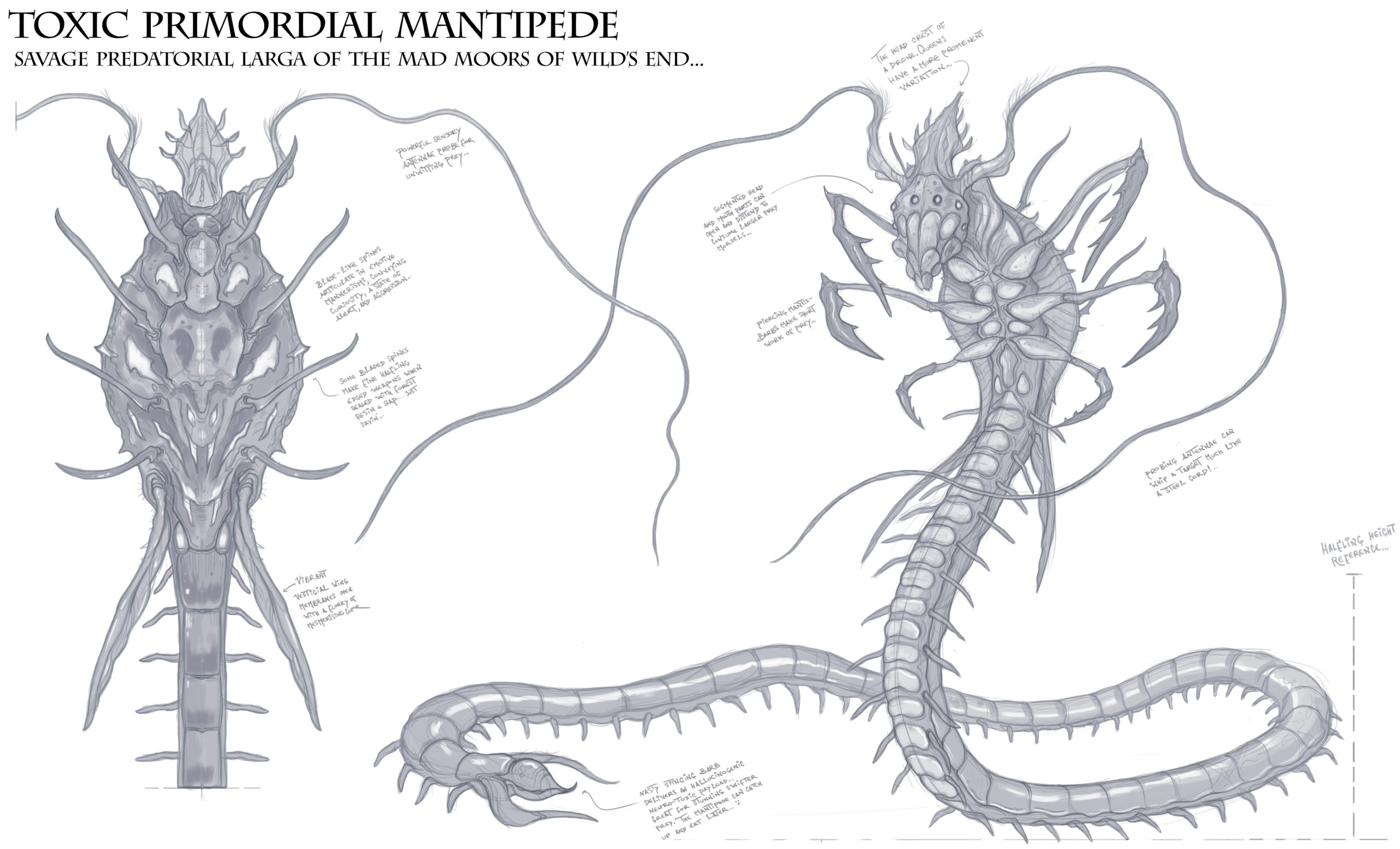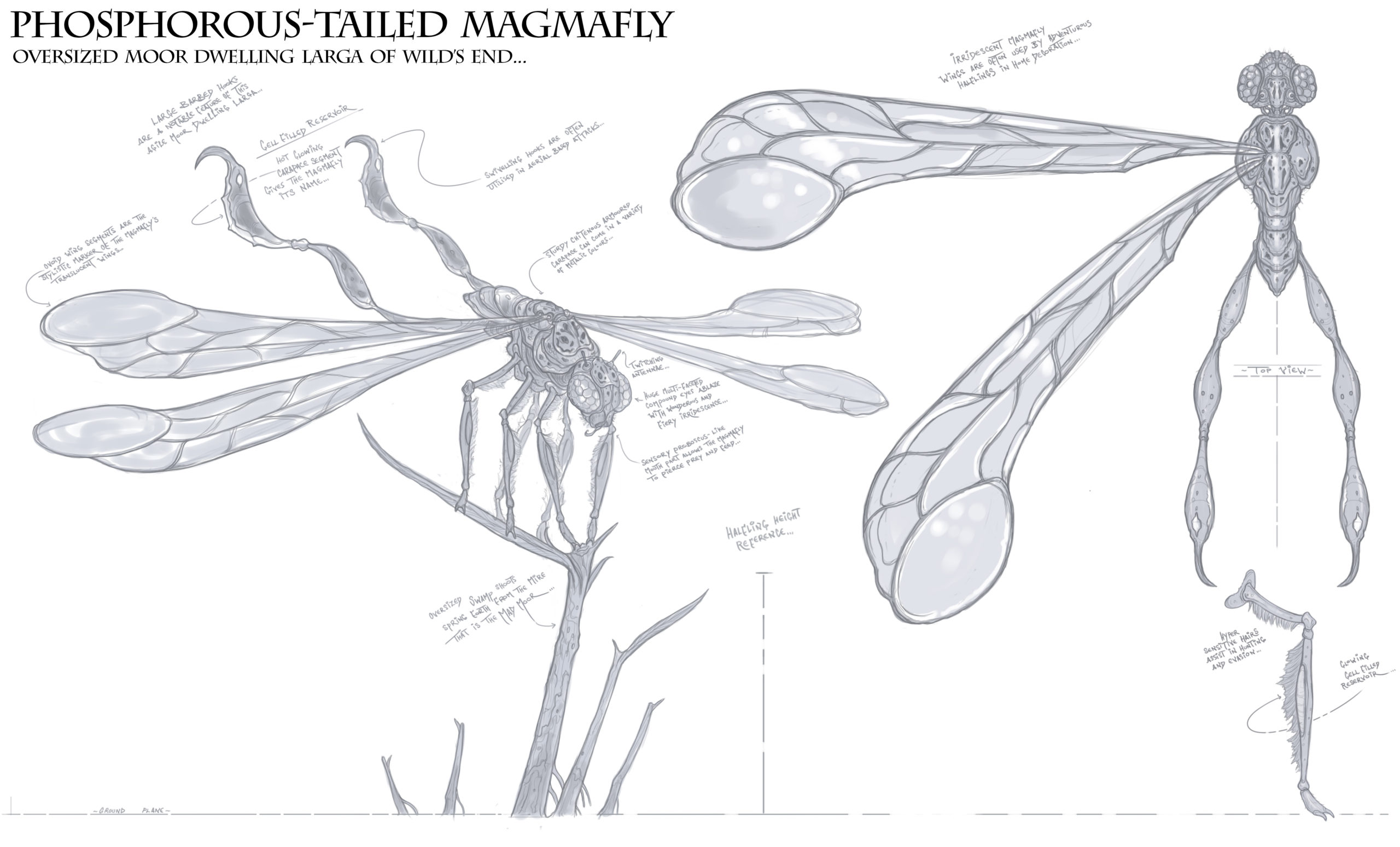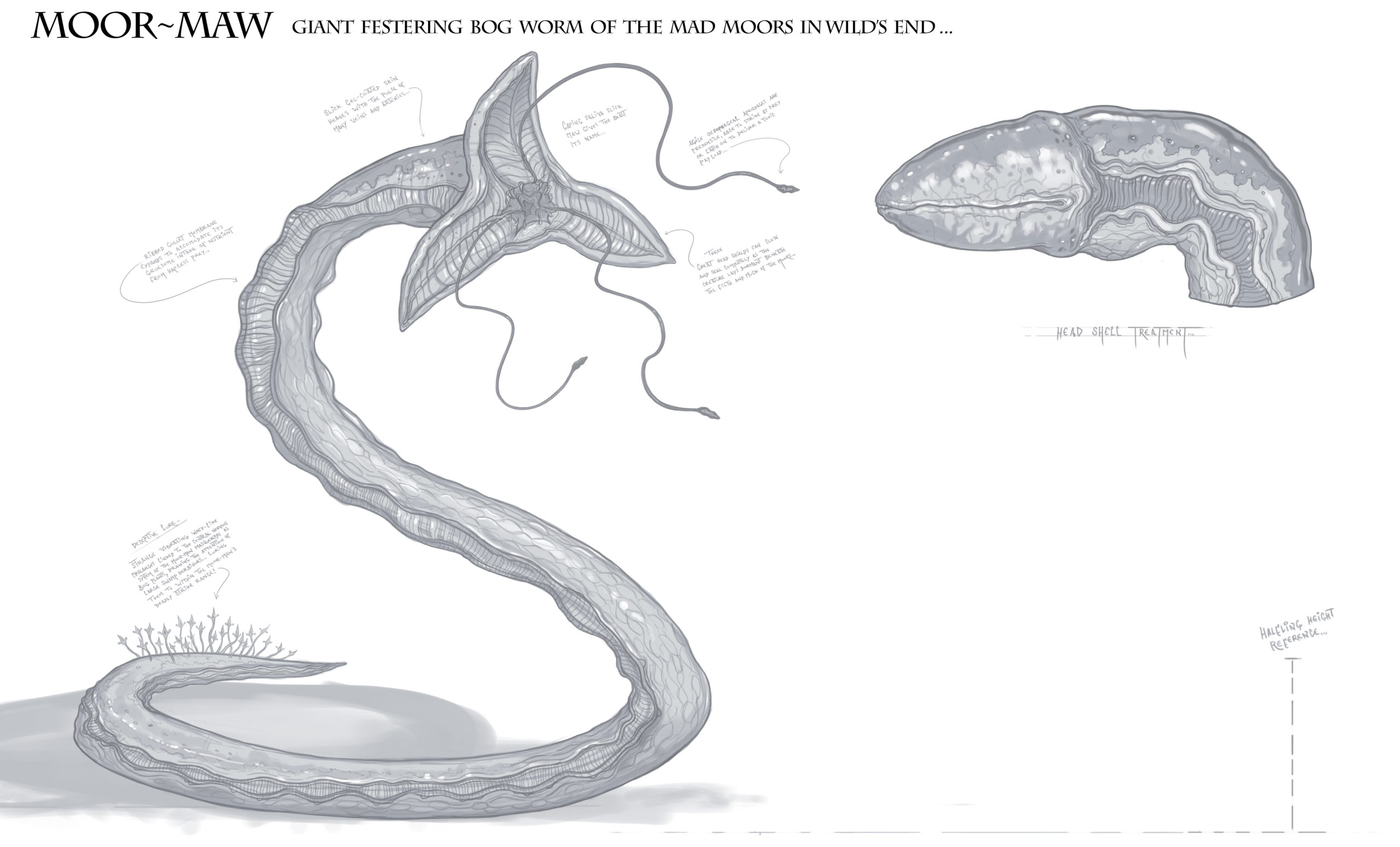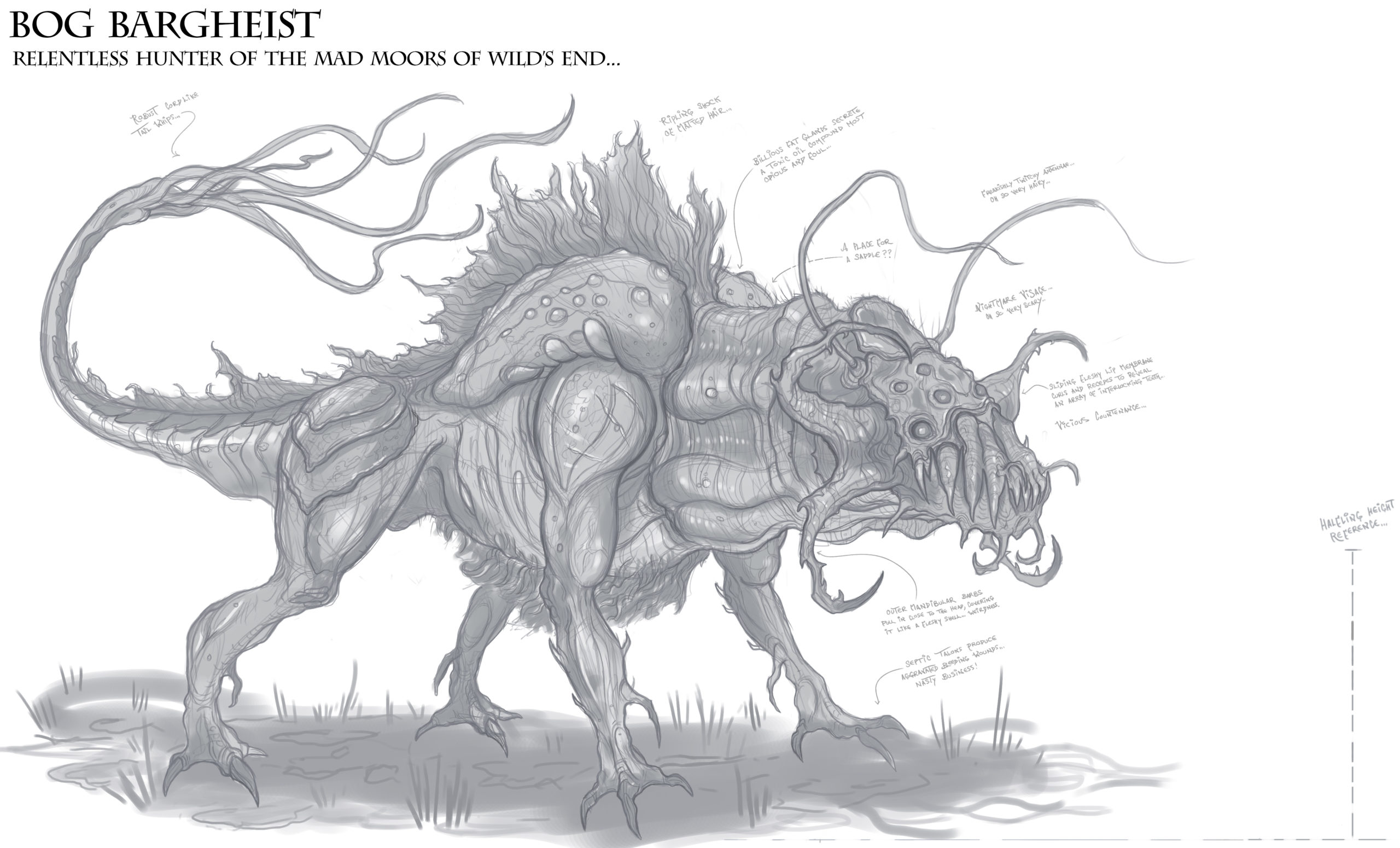Creature Feature: Mad Moor
Jared Pullen
As the pristine jungle waterways of Sorhiryth thin into shallow, silty delta, bleeding out to become the fetid marshlands of the Mad Moor, it is the odour that first assails your senses. The reek of the bog tarries long over the expanse; a blanket of filth visible to the naked eye – a pestilent shroud to still the breath of man and beast. The scene breaks upon the mind as a scourging wave upon a broken coast: writhing husks of hollowed bog shoots, the tortured forms of Shrivewither frozen in anguished repose and the cadaverous remnants of once living things stretch on in ruinous desolation; twisted silhouettes in the fog that seem to cry aloud, tormenting the sanity of men. The muck stirs… but perhaps you are mistaken… Was that movement? No? Perhaps the swirling of noxious vapours as something unseen parted the dense miasma like a veil? Only there is nothing. Nothing perhaps or maybe something? Yes? No.. Yes?… The very moors hold their breath, and so do you. Something shrieks afar off across the wastes, shattering focus and rending the fibers of your nerves, now sprung as loosed piano wire – and then nothing; the nothingness of pregnant silence. You swear the filth beneath your boots just heaved with the collective heartbeat of a myriad microorganisms. Silence. And then, a sound. That sound; as the terrible chittering of unnumbered Flesh-Beetles clamouring for prey in fearful concert, and the rattling of marrow leeched bones all at once.. And the chorus rises, vibrating with that chilling, fevered harmonic resonance to an ear splitting ululation; paralysing the wit, deafening your limbs to the heart’s enterrored cry to tear off into the swamp for your very life. Only shattered nerves will no longer obey the command to flee. Chitinous limbs, as hollow reeds packed with crab-like flesh, tremble with a frenzied violence, their sinews dressed red as scarlet vibrating at high speed, producing that peculiar oscillating sound; the herald of death to all who hear it. All courage flees as silence returns, and the Mad Moor exhales the rancid stench of her long bated breath. It is in silence that the segmented horror rises from the mire to pierce you, and the attack comes not from below, but from concealed heights above…
There is something altogether otherworldly and terribly disconcerting about centipedes. They are honestly the stuff of nightmares. Having for the most part spent my youth growing up in the Gold Coast Hinterland of Queensland Australia, I have seen a centipede or two in my time. The way they slice through decaying leaf litter at speed to overcome larger prey items with their onboard toxic payload, they spoke to me as the perfect inspirator for this ruggedly and eerily built Larva of Wild’s End. When JN said ‘The bugs are bigger there’, he wasn’t kidding, and that mantra, coupled with the need to break beyond the bleeding edge of sanity for the Mad Moor gave rise to this articulating horror; ‘The Toxic Primordial Mantipede.’
I’m a big fan of meaningful descriptors; that the name speaks volumes of the nature of the thing itself. I desired this creature to appear as if its origins were in the very ghastly film of the moors themselves, bearing a connection in material quality to the primordial filth below and to the harder edged sinuous structures that rise from it. Yet, having not been formed by pure chance of random process alone, it is rather by the direct agency and creative power of an unseen hand, hard at work with exquisite and intricate specificity of design. Perhaps once noble in its first estate, it has however since fallen; a now frightful proponent of the corrupted biome it now finds itself an intrinsic part of, serving the function of ‘ambush predator’ and ‘clean up crew’, to feed on hapless prey that stumble into the Moor, they having no part in them. It is a cunning hunter that relies on deception, intimidation, concealment and the sinister sanctuary in the stillness before the strike. It is in the waiting for the strike wherein enters madness…

At times it’s important to have familiar visual touchstones to engender a known emotional response in the player, but for this creature I wanted to push things a little further. It wasn’t enough to just make a ‘Giant Centipede’. There will be time and space for that, (see the segmented wonder of Fae Hollow for instance) as there will also be for other fantasy classics like ‘Giant Scorpions’ and their ilk, but this beasty had to touch on everything that makes the skin crawl and go beyond if possible. There had to be that ‘horror’ aspect, which the centipede has in spades, but the Mad Moor called for a denizen that plays havoc with the psyche, being a place of unquantifiable fears. It is after all the very province of madness.
This creature needed all the oozing dread of the centipede, but imbued with a patient savagery that in my mind only one other insect from our natural world could bring to the table; the praying mantis. Thus entered the ‘mantis’ component. What an amazing creature the praying mantis is! Such unique specificity of design as beauty of ornamentation meets deadly purpose! However I didn’t simply intend for our Toxic Primordial Mantipede to be a simple ‘monster mash up’, whereby one takes body parts of beasties one desires to showcase for their physical qualities and just jam them together in the single drawing. No, it had to be an integrated design, where attributes met physicality in a plausible manner. Yes, I could have endowed our creature here with those two weighty signature pincers that are the hallmark of the mantis, but in so doing the creature would have appeared encumbered, thus losing its range and speed, for which the centipede is well known. A simple mash-up would have seen a conflict in the specificity of design, which would not serve in this instance. Our creature also had to rear up, pause and then strike, so adding such weight would have diminished plausibility and made the creature appear feeble or perhaps even comical with this top heavy aspect, especially given the sheer length of the Mantipede’s body. So I needed to reduce the weight for this particular creation, while at the same time deliver on the attributes that I knew would furnish it to fulfill its frightful function in the zone.
Especially in this instance, it is best to allow function to govern form. Our Mantipede was to be fast over the terrain, moving through the large dead tree type structures that this creature had itself chewed out in pursuit for nutrients. It also had to navigate the shallow bogs and water volumes between the fetid land masses, so it could not be too heavily armoured, weighed down by a cumbersome carapace. The thought of this creature slicing through shallow water volumes like a swamp snake appealed to me, it’s complement of legs hauling in frenzied unison beneath a low profile shell that blended wonderfully with the bog about it. I once watched a huge cockroach swim across a shallow street gutter during a rain storm, crossing to the grass line. It sliced through with all the grace of an icebreaker, half floating, half barging as it went. Roaches can go anywhere, thrive anywhere. It seemed only fitting that our Mantipede should benefit from these same attributes, especially given its intrinsic nature also as an opportunistic scavenger roaming the rotten shoals. At the same time the Mantipede is also called to be a patient hunter, using concealment, blending with the environment’s taller structures to wait in ambush, which should make for some wonderful jump scares for our players as they wander the wastes of the Mad Moor. Yes, the Mantipede is designed for developing tension and threat, then delivering on that in stages. First that fearful harmonic sound, then the entrancing rearing up, in which it’s segmented head full of soulless eyes and distensible mouth parts comes forth from beneath a protective neck shroud, twitching and swivelling as the mantis does to regard its prey.
Though never one to bite off more than it can chew, (mostly) if encountered by larger groups and pressed to aggression before it can conceal itself, it’s wings (which are more prominent in its final adult stage of life) will flash open to reveal a dazzling display of colour, vibrating in rhythmic harmony with its myriad legs; a threat display intended to drive opponents away. All this to give our Mantipede time in which to slink back into the moors and find a silent place in which to regroup, camouflage and wait… and then pick you off one by one.

As the bog below belongs to the Mantipede, so the skies above the reek belong to the Phosphorous-Tailed Magmafly. Brightly coloured and war-like in physique, when it comes to swamps and moors there is no more appropriate a signature insect than the dragonfly. Knowing also that everything in Wild’s End must bear an oversized nature and larger than life character, our Magmafly was to be no exception. It was important to keep those key touchstones in line with the vibe and style of a dragonfly; the way they can hover like some kind of military aircraft and change direction on a whim, but also come to land in stillness and become almost part of the terrain itself was a key inspiration here. Silhouette was also critical when it came to all things concerning the Mad Moor, and so I resolved to ensure that we would see such creatures both at ease in the air and also resting upon oversized reeds emerging from the muck, providing unique shapes in the fog ahead. In many ways this creature actually assisted me to inform some of our bog botanicals, like the ‘Shredded Swamp shoot’ that you’ll find near the deeper bodies of water in the Moors.
While the Mad Moor take their name from the insanity that ensues from spending time lost amidst its maze-like structures which confuse powers to gauge distance, there needed to be an offset to the madness. There still needed to be a threat, and to balance where that threat would come from, but an overpowering malice need not be set within every creature living in the moors. We also needed a measure of startling beauty; dazzling, iridescent beauty – something to juxtapose the muted putridity of the moors and give us an explosion of colour. It is still a wild creature, and there is something militant about it, but the Magmafly was a perfect opportunity for us to blend in threat gradually between our NPC life from the outskirts of this unforgiving biome as it would transition with the gentler waterways of Wild’s End. Just like terrain must transition gradually between biome types, so too must our endemic life do so in many cases. Jarring changes in biome type and play experience together can make for a disjointed narrative in the environmental journey, and I wanted to avoid that as best I could for our playing Community.
I imagined our Magmafly would also be encountered atop the great tower lilies found in the more pristine waterways closer to Sorhiryth, making for a familiar Larga type to give Wild’s End the general vibe; that it is a wild place designed to make one feel undersized. I’ve hoped that players will be able to get up close and personal with these flying creatures to drink in details that ordinarily they may never see with the naked eye when viewing anything akin to a dragonfly. The vibrant fractal eyes, the iridescent wings and every hair fiber designed to create the feeling that the player is now miniscule and has entered a world where they are prey for creatures ordinarily much smaller than themselves. They aren’t a malignant creature as such; they simply do what they do, only in savage fashion, hunting smaller flying Larga on the wing with precision and speed. Grasping their prey with those articulating signature hook members, they tear in and enjoy a meal on the fly. Only as they settle to land, finishing off their now hollowed out victim, do not make the mistake of lingering too long to stare at such a radiant display… those brightly pulsing markings and translucent cells that carry their caustic blood close to the surface may be mesmerising to the eye, but you may be mistaken for a follow up meal!

The ground shakes, the mud flies skyward, and the stench assails you as the very earth swallows up the ground where once you stood, for the glutton of the bog has taken the field! Now, if you were to ask me why the Moor-Maw was made, the answer simply is ‘because I had to.’ What began as a simple exercise to showcase to our dear friend Bazgrim the sketch process for NPC creatures, quickly became our first real foray into Mad Moor endemic life. In a word; ‘grotesque’ and at all times possessed of abysmal table manners; such summarises the very nature of this disgusting yet remarkable creature. Inspired by the leech that once worked its way into my sock at summer camp to spend the night between my toes, the Moor-Maw fits the bill in every way. Able to remain dormant for long periods of time after binging on creatures that fall victim to the gasses in the moors, it is often mistaken for land masses within the biome itself. As time goes by and botanicals begin to grow over the creature’s bulk, it is barely discernible amidst the filth of the bog to all but the most trained eye. Many a witless traveller has spent the night on what they believed to be a copse of land, only to realise all too frightfully their very grave error.
Making the cut for our Mad Moor NPC life involved this creature being not only ghastly to behold, but also bearing a hunting technique born of deception. Being of considerable size, our Moor-Maw relies on energy efficiency and cunning to win its meal. While it won’t engage in open combat with anything that can mount a strong defense, it prefers to feed on large, slumbering prey, or to lure prey in with the promise of a meal, before striking out from the slime of the moors with its three prehensile tongues. These function much like the hooks of a squid to draw victims into that terrible waiting maw. I wanted to play up this element of deception, and so a special focus was given to the tail of the Moor-Maw, which bears unique bioluminescent appendages, signature to the creature, that appear much like some of the local flora eaten by the larger herbivorous beasts of the moors. As they draw near to take a nibble, our Moor-Maw senses the damage to itself, and lashes out when the moment is right with one high energy strike, latching on with those three powerful jaw flanges to quickly drain the creature of its vital essence. All I can say is that I had so much fun engaging in the process of bringing this creature into the world; if purely to contribute towards bolstering the gross factor of the Mad Moor alone.
Much of the inspiration here came from the happy thought of having this creature in one of 2 states when encountered; either glutted and expanded to gargantuan proportions, or skinny, wrinkled and ravenous. I hope we can encounter this beastie in both states, each potentially having their own impact upon the state of play. I can imagine it’s slick darkened hide blending with the terrain, but brilliantly punctuated with vibrant colour as the insides of its vast interior are revealed through its open mouth. The great news about a creature like this is that it can come in many varieties of colour to suit variations in swamp biome, and could have the ability to adapt to a jungle scenario as well.
Down the track you will see variants in both colour and form, but something that appealed to me was the notion of having the remnants of spears and swords and other piercing weapons found lodged in the creature’s hide. Such are remnants from other battles and tell a story in immersive fashion. Visual storytelling is something I am a huge fan of, and so I usually try to engage in it at every turn. I didn’t do it this time… but I think I’ll revisit this concept at render stage to add them in! Again, such a creature steps on familiar touchstones of fantasy, and nothing says ‘horror swamp’ quite like a gigantic leech with a fantasy twist! This is a creature that I hope could be a staged boss type encounter; something that can pose a memorable threat with it’s thick durable hide and high constitution to make combat a challenge as players try to mitigate and contend with its regenerative capabilities. I had such fun making this creature come to life and cannot wait for the render stages that will follow the mass blockout stage that I am in right now across the board. Fun awaits and there is always a reason to smile! Besides, just say the name ‘Moor-Maw’ 5 times fast with a cheery Scottish accent – guaranteed to bring a smile every time!

They cannot see you very well, making out only dim volumes and shapes; light and dark in the rancid gloom of the moors, but their olfactory senses operate in a manner scarcely comprehended. It is by sense of smell that these vile beasts navigate the rotten shoals, driven by a ravenous hunger that seems never sated. They can smell your sweat, the oils in the pores of your skin… they can taste in their mouth the very fear of adrenaline borne upon your shallow breath as they circle nearer and nearer to your hiding place…
If the hound of the Baskervilles were cast into a melting pot with 300 pounds of shredded fear and a voracious bird eating spider you might be approaching the territory in which was found inspiration for the awful visage of our Bog Bargheist. With all the tenacity of a rabid blood hound, the putridity of a venomous toad and the fright factor of a meat eating beetle crossed with an arachnid, it truly is a fearful sight to behold. This creature felt a fitting denizen of the Mad Moor in every sense, for what spooky shallow water biome would be complete without a bloodthirsty hound to pursue one across it? As an artist I didn’t have to look too far beyond the biome itself for inspiration, as well as our own earthly legends, and the Mad Moor would not nearly be as maddening without this terrifying addition.
Solitary, territorial, I’d imagined that this creature would offer up unique play conditions when encountered, not purely becoming aggressive on achieving line of sight alone. The play experience should be just that – an experience, and a memorable one. As an artist it’s not always purely the visual aspects that I’m thinking about when I’m creating for creature encounters… they also need to bring a feeling and a moment to the play experience that folk can talk about long after the game session is over. So I desired to bring a beastie to the moors that would not only frighten the blazes out of folk, but also have some unique rules of engagement. Imagine encountering our Bog Bargheist, marking up near the larger structures, patrolling with that articulating nightmare snout, drinking in the scents about it. Those mandibular talons upon the muzzle of the creature are acutely hardwired to its nervous system, and as it goes snuffling along, those same talons are brought forward, wrapping the snout like a facial shield, concealing that terrible array of teeth as they twitch and feel the ground in tandem with two horrid antenna. If it catches your scent, the beast will halt, and the gummy skin over those frightful teeth will peel back in a snarl. Mandibles flare outwards revealing that fleshy rot covered countenance; the signature of this vile thing.It is enough to give you the chills.
But that’s not the end of the surprise, for it has a sting in the tail too; a flail laced with the chemical musk of its own scent. If it lashes out successfully it will mark you, that should you run it can track its victim relentlessly across the country for miles to finish the job… if the venom doesn’t finish you first. That could certainly add some spice to the play experience. Yes this creature even gave me pause as I was drawing it, not only for its appearance, but more so for the thought that it should pursue without ever breaking off. I wish I could construct some clever argument so as to tell you that this creature came from hours of mental toil and carefully constructed fragments culminating in a marvelous revelatory moment to fashion the complete design, but that would not be true. In truth it was designed purely to scare the blazes out of players! Our Bog Bargheist fills a very specific niche in the biome as its tenacious hunter in residence; something lurking that creates the tension so needed in the Mad Moor. Fears are like odours; the memory of them remains with us long after the moment, but my hope is that this fear will be overcome by bravery equal to the foe’s tenacity. Bravery; it is the stuff that one long remembers, and I hope that this beastie can become as memorable as folklore to our players for years to come in that regard.
As always it has been a pleasure to spend even this small window in time with you, our treasured audience and Community. We could not continue in this epic adventure without you, and for this I thank you immensely. To be able to create creatures and biomes; to operate in far flung worlds unknown is for me a dream come true. Stay safe and strong and look after eachother… it is a wild place out there! Always bring friends…
| Producers’ Letter | Monthly Recap | Introducing Tim Schuhler | Creature Feature: Mad Moor | The Bait – Pt. 2 | How Game Worlds Foster Creativity |